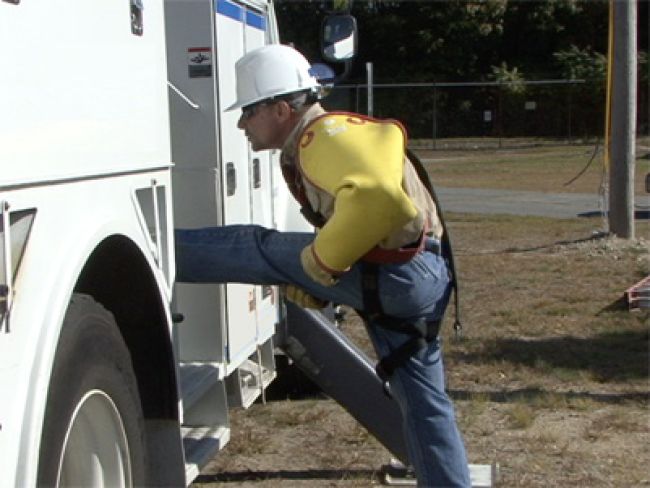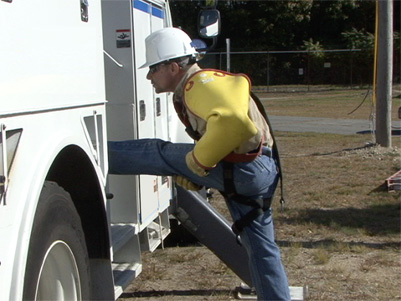
Understanding and Preventing Lower Back Pain in the Electric Utility Industry

“I don’t know what I did to cause this injury, Doc. I’ve had lower back pain on and off for the past five years, but it’s never been like this before. All I did was reach under the boom for a roll of cable on the truck when I felt something give in my back and then felt shooting pain down both legs. What the heck happened?”
This is not an unusual story. When I used to practice as a chiropractic orthopedist, I heard similar accounts on a daily basis. Lower back pain affects utility workers in epidemic proportions. In 2004, my company surveyed 224 employees of a public electric utility, and the results revealed that more than one of every five lineworkers reported living with moderate to severe lower back pain on a weekly or daily basis. There are valid reasons why most lineworkers believe that lower back pain is just a consequence of the work they do, but the good news is that it doesn’t have to be that way.
The Mechanics of Back Pain
Most lower back pain is mechanical in nature, meaning it does not come from cancers, other diseases or infections. But it doesn’t necessarily come from performing physical work either. All physical work causes some daily microscopic wear and tear of your body, and the more a job requires you to do physically, the more wear and tear will occur. Before you start looking for another job, however, remember that your body is fully capable of repairing the vast majority of the wear and tear that occurs from demanding physical work. The painful conditions that most lineworkers experience in their careers occur because the balance between the amount of damage done each day and the repair that occurs each day gets thrown out of whack. How you position and move your body as you perform work dramatically affects how much wear and tear you sustain each day. Habitually working with stressful techniques can cause more microscopic damage on a daily basis than your body is capable of repairing. If it is not repaired, this microscopic damage accumulates over time and eventually causes painful conditions. “Cumulative trauma” is the name given to this slow accumulation of microscopic damage. As cumulative trauma increases over the years, the end results commonly are painful conditions, serious injuries and degenerative arthritis.
Because your spine is a mechanical system, it is designed to move, to generate force and to sustain loads in very specific ways. For example, when you work with a spoon and spade to manually dig a hole with a vertical spine, the load of your upper body and shovel is supported by the bones and discs of the spine. The muscles around your spine are relatively quiet because they do not have to support that load. Bending at the waist when digging shifts that load off the bones and onto the lower back, gluteal and hamstring muscles. The farther forward you bend, the more leverage gravity gains against your upper body weight, and the harder those muscles have to contract to counteract the downward force of gravity on your torso. The muscles can work five to eight times harder when you are fully bent over than when you are standing erect. Repetitive bending overworks and fatigues those muscles and microscopically tears more muscle tissue than you are able to repair each day. Digging the hole did not cause your back pain; it was caused because you were bent over while doing so and overworked your muscles. Overworked and damaged muscles go into spasm and cause pain.
Twisting while bending will tear microscopic elastic fibers that strengthen the walls of the discs. Over time, this repetitive tearing causes weakening and degeneration of the discs. Habitually bending and twisting, unloading your truck, lifting items from the ground, engaging in stick work from ladders or buckets, getting into and out of your truck, putting out line hose or even raking leaves at home can cause a severe amount of damage to accumulate over the years. This is why back problems are so common.
More Good News
You do not have to stop all bending at the waist to feel great every day. You couldn’t even if you wanted to – and you don’t want to. Some bending is necessary to keep the lower back muscles healthy. It’s the twisting while you’re bending that you want stop as much as is possible. And with effort, you can easily stop about 90 percent of this twisting.
Bending typically occurs when we are reaching out for something that is far from us. It also occurs when lowering the reach of the hands. Getting your body closer to what you are reaching for, if possible, will allow you to lessen the bend. Squatting correctly lowers the hands with minimal bending.
Twisting typically occurs when the torso rotates to reach farther with one hand than the other. It also happens when you move your torso to work in a new direction but do not move your feet to be in alignment with your torso. Lazy feet are the greatest cause of twisting. Foot movement is critical, so be sure your feet and chest face the same direction when working in the bucket, on a pole or on the ground.
You also must develop the habit of keeping your feet and chest facing the same direction when wrenching, using hot sticks, putting on line hose, jacking cable or skinning cable from the bucket. Moving your feet around the pole as needed to minimize twisting will protect your back, too. When turning your body in your belt, you should rotate slightly on your gaffs and ankles, slightly at the knees and mostly on your hip joints. This lessens the twist of the back.
Give some thought to how you load equipment on your trucks. If you have to bend under the boom every time to reach a crossarm or roll of cable, back pain will eventually come to visit you. If your truck is so disorganized that you cannot get your feet close enough to reach something, you will likely bend and twist to reach for it.
Learn how to use shovels, spoons and spades, post-hole diggers, rakes and brooms while keeping your upper body vertical. Learn to keep your feet and chest facing the same direction so you do not twist when performing these activities.
Pull manhole covers and transformer vault covers with a vertical spine. Your legs and hips bend to lower you, and they provide all of the power to lift those covers. The feet provide all of the movement back and forth or left and right. The hook handle should never leave your belly button area. If it does, you probably are twisting and need to adjust your body positioning.
Lean back and walk back when using cant hooks to rotate poles instead of twisting as you pull the cant hook across your body.
Learn a variety of different lifting techniques that will allow you to use good squats when appropriate. Avoid squats using techniques like golfer’s lifts and support lifts when you don’t need to squat. Of course, always employ good lifting practices, such as utilizing team lifts or cranes for objects heavier than 50 pounds.
Using better body mechanics lessens the cumulative trauma you do to yourself every day. By increasing the capacity to repair that damage, you also improve your quality of life. Eating healthfully and getting exercise are key to maximizing the repair to our bodies. Seven to eight hours of sleep also is important as this is when growth hormone levels change and a lot of your muscle repair occurs.
Keep Stretching
Stretching your lower back, gluteal and hamstring muscles each day is extremely important to keep your muscles and joints healthy.
Stretching reduces muscle spasms so joints move more correctly. It tears up scar tissue that forms in the muscles and joints so they too move with less wear and tear. Stretching also reduces pain and discomfort, restores blood flow, which improves muscle repair and growth, and even restores strength when you are fatigued. In the long run, stretching can reduce the amount of degenerative arthritis you develop over your career.
A warmup stretch at the operations center is helpful, but the best place to stretch is on the job site as part of your safety briefing before you start work. Microbreak stretching can be done after performing certain tasks that stress muscles and may fatigue them. Examples include stretching your hamstrings after being in the bucket, or stretching your quadriceps after working on a pole. And of course, you can stretch at home, too. Stretching before you go to sleep will help you sleep better if you typically develop soreness or stiffness in your back or hips during the night as your muscles tighten up.
One final thing you can do to minimize lower back pain and keep your body strong and healthy is to keep your core muscles strong. There are many simple core strengthening exercises you can learn and perform at home – a simple online search will lead you to many of them.
In summary, it’s your quality of life that is on the line here, and you don’t want to lose sight of that. You must ask yourself, what is your quality of life worth to you and what are you willing to do to protect it?
About the Author: Dr. Andrew Murro, DC, DABCO, was a practicing chiropractic orthopedist from 1984 to 1999. He is president of Business Health Resources LLC and founder of the Ergo-Power Injury Prevention Program. Since 1999 Murro has worked with electric, gas and water utilities, as well as companies in the manufacturing and service industries, to help them develop and implement sustainable soft tissue injury prevention strategies. He can be reached at amurro@ergo-power.com.

